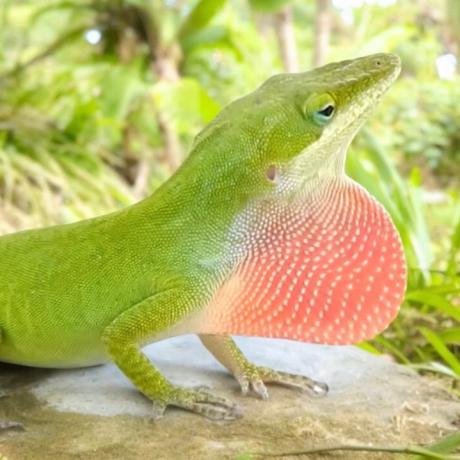

The Green Anoles is a tree-dwelling lizard that's native to the South-eastern United States and Caribbean islands. These are an ideal species for beginners as they are very hardy in captivity if the conditions are correct.
| Origin | Southern and Central America |
|---|---|
| Environment | Vegetation/Shrubs |
| Adults Size | Up to 20cm |
| Suitability | Beginner |
| Lifespan | Up to 8 years |
| Food Type | Insects |
The Green Anole is a small, slender species growing to a total length of 13-20cm (5-8”) from snout to tip of tail. The tail makes up two-thirds of their total length, as this is essential for balancing. They are a fast species of lizard jumping through vegetation. They are also known as “American Chameleon” as they have the ability to change colour from green to brown, this depends on the environment around them and their mood.
Males are very territorial and aggressive towards each other. They will display ownership of an area with head bobbing, extension of a crest on their neck/back and extending a colourful throat fan/dewlap. The dewlap is colourful, normally a pink/red colour. Females can also show a colourful dewlap, but these are normally much smaller.
They are native to the southern United States, Central American and the Caribbean. They can be seen resting on walls, fences or within the vegetation of low shrubs and gardens.
Green Anoles should be kept in a tall vivarium, as they prefer height to floor space. Ideally one male and four females should be kept in a minimum vivarium measuring 90x60x30cm (36x24x12”). Due to the territorial nature of the males, if you do have more than one male, it is best to separate them or provide a larger enclosure. If you provide plenty of plants, the males should establish their own territory within the enclosure.
If housing five Green Anoles, provide at least two basking spots to prevent any fighting. Maintain the temperature to 23-30C (74-86F) during the day, this should drop no lower than 20C (68F) at night. The use of a thermostat must be used to prevent the enclosure from becoming too cold or over heated. Green Anoles need the use of a 5% UV light, this helps to absorb calcium into their diet for bone and egg development.
For a substrate on the floor, we recommend the a coco substrate as this helps keep humidity levels up. We then place a layer of leaf litter or bark chips over the top to make the enclosure look more realistic. Artificial plants can be used, but if your enclosure allows it, the use of living plants makes it more rewarding. Spray the vegetation each day to allow the Anoles to drink as they will rarely drink from s bowl. This spraying will also help keep the humidity levels in the range of 60-70%.
The Green Anole will eat several small insects per day; feed your Anoles on crickets, small locusts, wax worms, mini mealworms, flies and other insects they would normally find in the wild like small spiders. The food should be dusted with a calcium/vitamin supplement and applied as the manufactures recommendations.